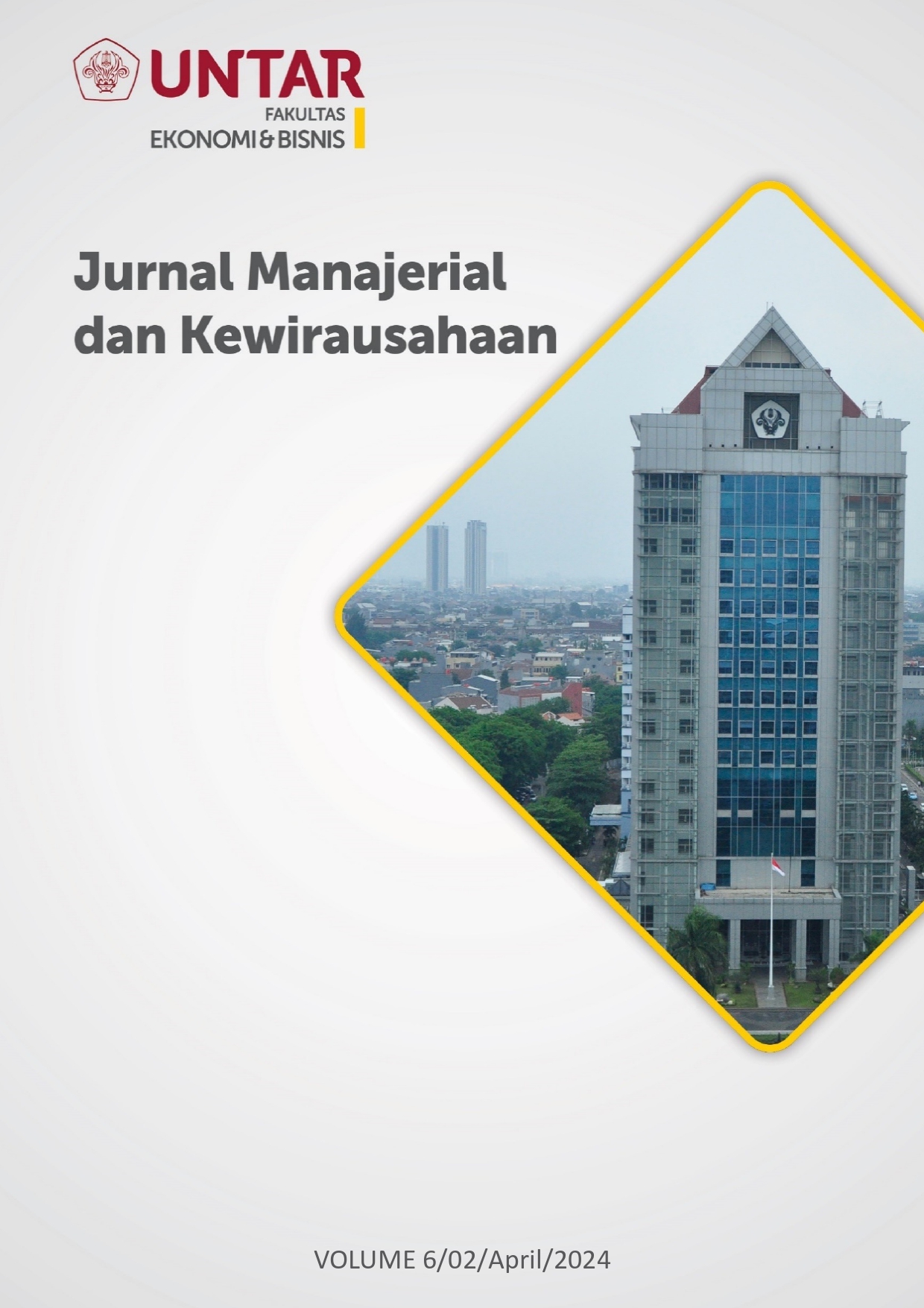Faktor-Faktor yang Mempengaruhi Propensity to Indebtedness Pengguna Shopee Paylater di Jakarta
Main Article Content
Abstract
ini memicu pengguna untuk semakin melakukan pembelian yang tidak bijak dan akhirnya terjebak dalam kredit. Penelitian ini bertujuan untuk mengetahui pengaruh financial literacy, materialism, money value, dan compulsive buying terhadap propensity to indebtedness. Sampel yang diambil adalah 360 Generasi Z pengguna Shopee PayLater dan berdomisili di Jakarta. Data dikumpulkan melalui kuesioner dengan menggunakan teknik pengambilan sampel purposive sampling. Data yang terkumpul kemudian diolah menggunakan metode analisis data PLS-SEM. Hasil penelitian ini menunjukkan terdapat pengaruh negatif financial literacy terhadap propensity to indebtedness, terdapat pengaruh positif materialism terhadap propensity to indebtedness, dan terdapat pengaruh positif compulsive buying terhadap propensity to indebtedness. Namun, tidak terdapat pengaruh money value terhadap propensity to indebtedness.
The PayLater payment method is becoming increasingly popular due to the fact that many people are starting to switch from using credit cards to PayLater services and this is dominated by Generation Z. The ease of payment provided by many e-commerce sites triggers users to increasingly make unwise purchases and eventually get stuck in credit. This study aims to determine the effect of financial literacy, materialism, money value, and compulsive buying on propensity to indebtedness. The samples taken was 360 Generation Z users of Shopee PayLater and domiciled in Jakarta. Data was collected through a questionnaire using a purposive sampling technique. The collected data was then processed using the PLS-SEM data analysis method. The results of this study indicate that there is a negative influence of financial literacy on propensity to indebtedness, there is a positive influence of materialism on propensity to indebtedness, and there is a positive influence of compulsive buying on propensity to indebtedness. However, there is no influence of money value on propensity to indebtedness.
Article Details

This work is licensed under a Creative Commons Attribution-NonCommercial-ShareAlike 4.0 International License.
This work is licensed under a Jurnal Muara Ilmu Ekonomi dan Bisnis Creative Commons Attribution-ShareAlike 4.0 International License.,/p>
References
Ajzen, I. (1991). The Theory of Planned Behavior. Organizational Behavior and Human Decision Processes, 50(2), 179–211. https://doi.org/10.1016/0749-5978(91)90020-T
Azma, N., Rahman, M., Adeyemi, A. A., & Rahman, M. K. (2019). Propensity toward Indebtedness: Evidence from Malaysia. Review of Behavioral Finance, 11(2), 188–200. https://doi.org/10.1108/RBF-05-2017-0046
Bank Indonesia. (2023). Laporan Perekonomian Provinsi DKI Jakarta Februari 2023. https://www.bi.go.id/id/publikasi/laporan/lpp/Pages/Laoran-Perekonomian-Provinsi-DKI-Jakarta-Februari-2023.aspx
Doosti, B. A., & Karampour, A. K. (2017). The Impact of Behavioral Factors on Propensity Toward Indebtedness. Journal of Advances in Computer Engineering and Technology, 3(3), 145–152. https://doaj.org/article/7f457bc05f604a5c85553018bb213bf8
Figueira, R. F., & Pereira, R. de C. D. F. (2014). Devo, não Nego, Pago Quando Puder: Uma Análise dos Antecedentes do Endividamento do Consumidor. Revista Brasileira de Marketing, 13(5), 124–138. https://doi.org/10.5585/remark.v13i5.2744
Flores, S. A. M., & Bidarte, M. V. D. (2019). Style Consumption and Propensity to Indebtedness Evidence on the Peace Border. Revista de Administração Da UFSM, 12(1), 142–158. http://dx.doi.org/10.5902/1983465917740
Flores, S. A. M., & Vieira, K. M. (2014). Propensity toward indebtedness: An analysis using behavioral factors. Journal of Behavioral and Experimental Finance, 3, 1–10. https://doi.org/10.1016/j.jbef.2014.05.001
Ghozali, I. (2021). Partial Least Squares: Konsep, Teknik dan Aplikasi Menggunakan Program SmartPLS 3.2.9 Untuk Penelitian Empiris. Badan Penerbit Universitas Diponegoro.
Hartanto, A. Y. (2022, Oktober 28). Apakah Gen Z Terlalu Boros dalam Menggunakan Paylater? Tirto.Id. https://tirto.id/apakah-gen-z-terlalu-boros-dalam-menggunakan-paylater-gxPn
Hartanto, A. Y. (2022, November 2). Riset: Mayoritas Menggunakan Paylater 2-5 Kali per Bulan. Tirto.Id. https://tirto.id/riset-mayoritas-menggunakan-paylater-2-5-kali-per-bulan-gx1L
Jonathan, N. & Setyawan, I. R. (2022). Pengaruh Financial Literacy, Financial Inclusion dan Financial Behaviour terhadap Minat Berinvestasi Mahasiswa. Jurnal Manajerial dan Kewirausahaan, 4(4), 891-898. https://doi.org/10.24912/jmk.v4i4.20540
Lavinda. (2023, Juni 14). Riset KIC dan Kredivo: Paylater Jadi Pembayaran Favorit di e-Commerce. Katadata.Co.Id. https://katadata.co.id/lavinda/digital/6489b589ca8cf/riset-kic-dan-kredivo-paylater-jadi-pembayaran-favorit-di-e-commerce
Leite, P. L., Rangé, B. P., Ribas Junior, R. de C., Filomensky, T. Z., & Silva, A. C. de O. e. (2011). Tradução e adaptação semântica da Compulsive Buying Scale para o português brasileiro. Jornal Brasileiro de Psiquiatria, 60(3), 176–181. https://doi.org/10.1590/S0047-20852011000300005
Lestari A, A., & Kristiyanto, D. (2018). Pengaruh Orientasi Fashion, Money Attitude dan Self-Esteem terhadap Perilaku Pembelian Kompulsif pada Remaja (Studi pada Konsumen Produk Telepon Selular di Surabaya). BISMA (Bisnis Dan Manajemen), 4(2), 128. https://doi.org/10.26740/bisma.v4n2.p128-144
Minella, J. M., Bertosso, H., Pauli, J., & Corte, V. F. D. (2017). A Influência do Materialismo, Educação Financeira e Valor Atribuído ao Dinheiro na Propensão ao Endividamento de Jovens. Gestão & Planejamento, 18, 182–201. https://doi.org/10.21714/2178-8030gep.v18.4257
Mitta, D. & Pamungkas, A. S. (2022). Pengaruh Financial Literacy, Materialism, Risk Perception, dan Money Value terhadap Propensity to Indebtedness. Jurnal Manajerial dan Kewirausahaan, 4(2), 339–347. https://doi.org/10.24912/jmk.v4i2.18229
Muhamad, N. (2023, August 23). Gen Z dan Milenial Jadi Penyumbang Kredit Macet Pinjol Terbesar pada Juni 2023. http://bit.ly/3vrhUnS
Okicic, J., Jukan, M. K., Kakeš, D., & Herić, M. (2020). The Impact of Behavioral Factors on Propensity toward Indebtedness among Youth: A Structural Equation Modelling Approach. https://www.researchgate.net/publication/344336962
Patulak, L. E., Sarita, B., & Hamid, W. (2020). Pengaruh Emosi, Materialisme, Literasi Keuangan, Persepsi Resiko, dan Pengalaman Keuangan terhadap Propensity to Indebtedness (Studi pada Nasabah Kredit Plus Kendari. JUMBO (Jurnal Manajemen, Bisnis Dan Organisasi), 4(3), 31–42. http://dx.doi.org/10.33772/jumbo.v4i3.16357
Potrich, A. C. G., Kelmara, M. V., & Filho, R. B. (2016). Modelando a propensão ao endividamento: os fatores comportamentais e socioeconômicos são determinantes? Revista Facultad de Ciencias Económicas, 24(2). https://doi.org/10.18359/rfce.2214
Potrich, A. C. G., & Vieira, K. M. (2018). Demystifying financial literacy: a behavioral perspective analysis. Management Research Review, 41(9), 1047–1068. https://doi.org/10.1108/MRR-08-2017-0263
Prashella, D. A., & Leon, F. M. (2020). Financial Literacy in Millenials Generation in Indonesia. Proceedings of the International Conference on Management, Accounting, and Economy (ICMAE 2020), 151, 322–325. https://doi.org/10.2991/aebmr.k.200915.072
Setyowati, D. (2022, Januari 13). Survei KIC: Gen Z dan Milenial Pakai Paylater untuk Belanja Busana. Katadata.Co.Id. https://katadata.co.id/desysetyowati/digital/61e0ecf4b1b96/survei-kic-gen-z-dan-milenial-pakai-paylater-untuk-belanja-busana
Wahono, H. K., & Pertiwi, D. (2020). Pengaruh Financial Literacy, Materialism, Compulsive Buying Terhadap Propensity to Indebtedness. International Journal of Financial and Investment Studies (IJFIS), 1(1), 1–14. https://doi.org/10.9744/ijfis.1.1.1-14



